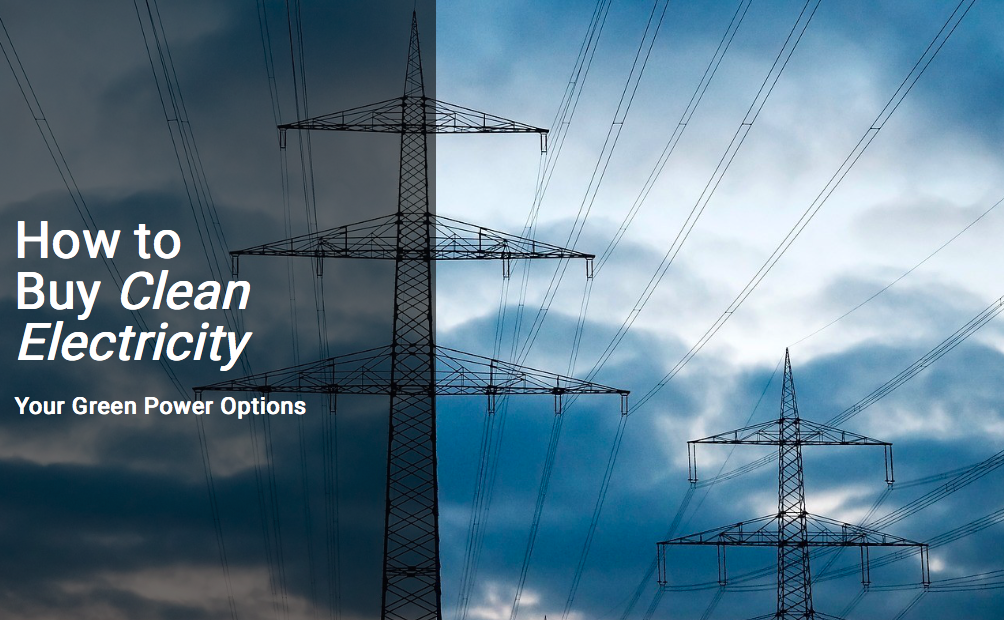
How can I buy clean electricity?
We hear a lot of people ask this question, which is a good sign. It means more people want to do the right thing. They want to help in the effort to get away from burning fossils for power.
But when they start looking around for options for buying green power, the often come up empty-handed. Why is it so hard to buy clean electricity? This article will provide guidance on how to do it in Massachusetts.
Why Buying Green Power is Important
Why keep relying on resources that are going to run out some day when we have renewable sources that can be further developed? Extracting those non-renewable resources from the planet can have significant negative environmental impacts, and burning them produces pollution that affects the health of both humans and the ecosystems upon which all life depends.
The fastest way to make the transition from non-renewable to renewable energy is for more people to support it with their dollars – such as buying clean electricity.
Clean Electricity Options
According to the federal Department of Energy’s Buying Clean Electricity page…
At least 50% of customers have the option to purchase renewable electricity directly from their power supplier, and everyone has the option of purchasing renewable energy certificates.
It goes on to explain the three basic options people may or may not have for buying clean electricity:
- Green pricing from your current provider. More power companies are allowing customers to pay a slightly higher price in order to know that their dollars are supporting the renewable electricity part of the company’s power generation mix.
- Deregulated electricity markets in some states mean clean electricity power generators can join the market themselves as providers or partner with default suppliers who want to up the amount of green power in the power generation mix distributed to its customers. Again, the price of this power will be slightly higher.
- Green certificates are another way to support clean electricity when there isn’t any green power options in your area. The green certificates (also called “green tags” or “renewable energy certificates” or “tradable renewable certificates”) are a way of putting money towards the support of companies that generate greener power. For individual consumers, this would mean spending money over and above your current electricity bill in order to support the continued development of clean electricity.
Going Green in Massachusetts
How does this pan out for residents of Massachusetts? First, let’s take a look at what the main power suppliers offer in the way of green pricing:
National Grid (Massachusetts Electric, Nantucket Electric Company)
There is no green pricing option with National Grid. Its website does talk about its solar energy projects, which when completed will generate about 21 megawatts of solar electricity. The website also mentions the “ambitious” goal set in the July 2008 Green Communities Act requiring electric companies in the state to provide up to 25% of their electrical load from renewable energy by 2020. It does not, however, mention where it’s at on meeting that requirement.
What National Grid does offer is a list of GreenUp renewable energy providers you can sign up with to support clean electricity production. When you enroll in this program, you’ll see a separate GreenUp line item on your regular National Grid bill. Check out all the providers, what they offer in terms of the mix of renewable energy, and what they cost on National Grid’s Massachusetts GreenUp Providers page.
Eversource Energy (WMECo, NSTAR Electric)
Eversource is even more obtuse about its green power options. You can search its site up, down and sideways but you won’t find anything about green pricing or clean electricity producers. This is somewhat discouraging from an energy company serving 3.6 million customers in Massachusetts, Connecticut, and New Hampshire.
Municipal Lighting Plants (MLPs)
There are 41 communities that have established their own electric plants to supply some or all of the electricity for a specific municipality. If you live in one of these towns, you should check with your MLP to see what they offer in terms of green power options.
Unitil
Like the other big utility companies, Unitil doesn’t say anything about green pricing or choosing a green power provider.
Your Best Bet: Green Powered Program
If you really want to support clean electricity in Massachusetts and New England, your best option is to enroll in Green Powered, a special program offered by the Green Energy Consumers Alliance.
It will cost you an additional $10-$20 on top of your regular electric bill depending on your home electricity usage and what option you choose. And it will be included as a line item on your regular bill, not a separate payment. But here’s the thing: Because the organization offering the program is a non-profit, you can deduct what you pay as a charitable donation if you itemize on federal tax return. And all the green power you’re supporting is generated locally in New England.
Supporting hundreds of local renewable energy projects (wind, solar, hydro, and biomass) and taking a federal income tax deduction for it is a great way to play your part in boosting the demand for more clean electricity.
Make Your Own Clean Electricity
When you really want to make a statement in the movement to transition to greener power, then you should seriously consider installing a residential solar energy system at your home.
We recently busted three renewable energy myths, including affordability, to show how it’s easier and more affordable than ever to have a solar panel system at your home. Learn more, including how to pay for it, on the NEEECO Solar Energy page!
Call (781) 514-5882 or contact us to get started with a no-cost Mass Save® home energy assessment.
